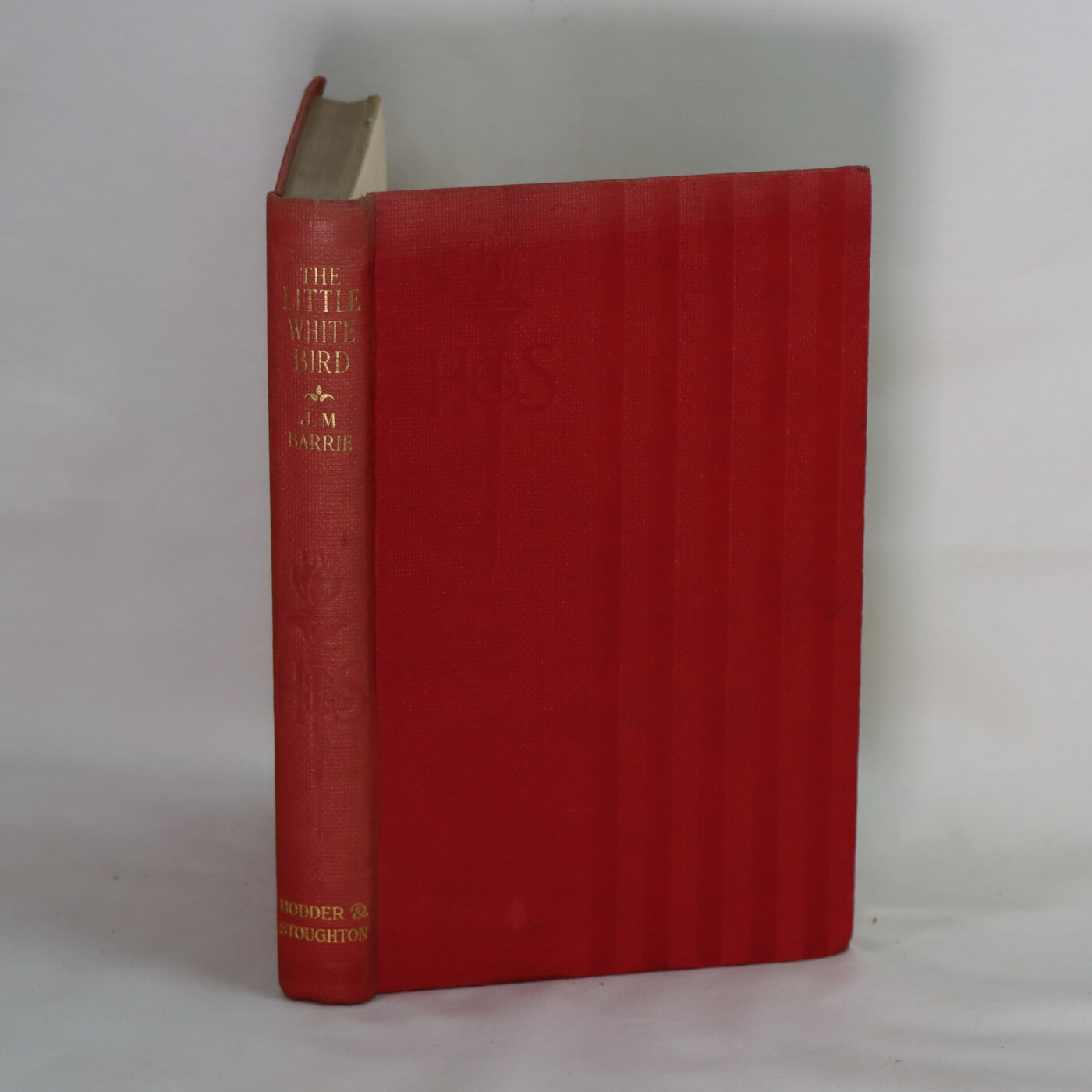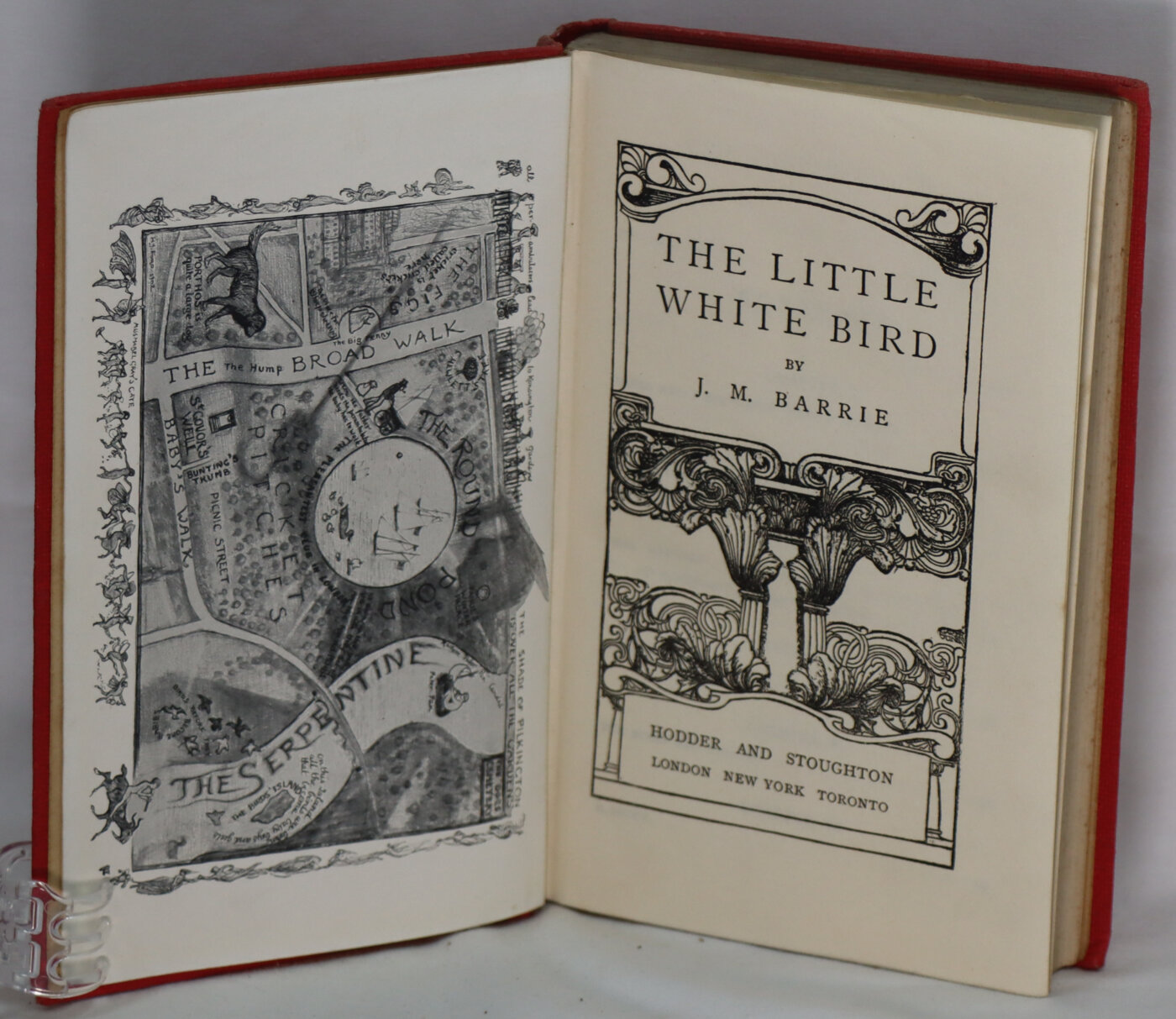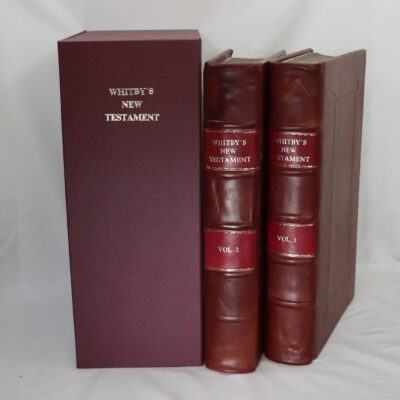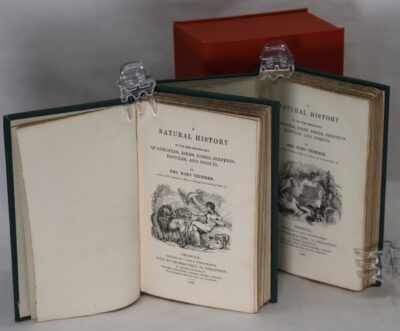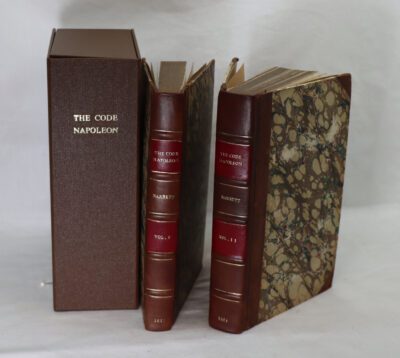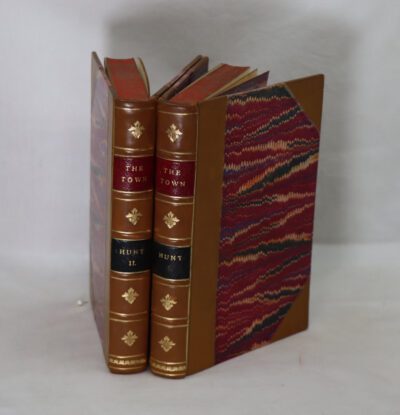The search for your perfect item starts here ...
The Little White Bird.
By J M Barrie
Printed: Circa 1950
Publisher: Hodder & Stoughton. London
| Dimensions | 12 × 18 × 2 cm |
|---|---|
| Language |
Language: English
Size (cminches): 12 x 18 x 2
Condition: Fine (See explanation of ratings)
Item information
Description
Red cloth binding with gilt title on the spine.
-
We provide an in-depth photographic presentation of this item to stimulate your feeling and touch. More traditional book descriptions are immediately available.
-
Note: This book carries a £5.00 discount to those that subscribe to the F.B.A. mailing list.
No Edition Remarks. 312 pages. No dust jacket. Red cloth with gilt lettering. Rough-cut pages. Lettering remains bright and clear. A lovely book all in all. Note: This book may be a First Edition as it appears dated 1902. Condition: Near fine. First Edition, with a frontispiece Map ‘A Child’s Map of Kensington Gardens’. A series of short stories recounting the author’s day to day activities in London with a fantastical bent, set around Kensington Gardens, including one where Peter Pan makes his very first appearance (see map showing 1902). Sir James Matthew BARRIE, 1st Baronet, OM (1860 – 1937) was a Scottish novelist and playwright, best remembered as the creator of PETER PAN.
That said: as one cannot prove it is a First Edition it is offered for sale at £98.00.
The Little White Bird is a novel by the Scottish writer J. M. Barrie, ranging in tone from fantasy and whimsy to social comedy with dark, aggressive undertones. It was published in November 1902, by Hodder & Stoughton in the UK and Scribner’s in the US (and the latter also published it serially in the monthly Scribner’s Magazine from August to November). The book attained prominence and longevity thanks to several chapters written in a softer tone than the rest of the book, which introduced the character and mythology of Peter Pan. In 1906, those chapters were published separately as a children’s book, Peter Pan in Kensington Gardens.
The Peter Pan story began as one chapter and grew to an “elaborate book-within-a-book” of more than one hundred pages during the four years Barrie worked on The Little White Bird..
The complete book has also been published under the title The Little White Bird, or Adventures in Kensington Gardens.
Sir James Matthew Barrie, 1st Baronet, OM (9 May 1860 – 19 June 1937) was a Scottish novelist and playwright, best remembered as the creator of Peter Pan. He was born and educated in Scotland and then moved to London, where he wrote several successful novels and plays. There he met the Llewelyn Davies boys, who inspired him to write about a baby boy who has magical adventures in Kensington Gardens (first included in Barrie’s 1902 adult novel The Little White Bird), then to write Peter Pan, or The Boy Who Wouldn’t Grow Up, a 1904 West End “fairy play” about an ageless boy and an ordinary girl named Wendy who have adventures in the fantasy setting of Neverland.
Although he continued to write successfully, Peter Pan overshadowed his other work, and is credited with popularizing the name Wendy. Barrie unofficially adopted the Davies boys following the deaths of their parents. Barrie was made a baronet by George V on 14 June 1913, and a member of the Order of Merit in the 1922 New Year Honours. Before his death, he gave the rights to the Peter Pan works to Great Ormond Street Hospital for Children in London, which continues to benefit from them.
Hodder & Stoughton is a British publishing house, now an imprint of Hachette.History: Early history: The firm has its origins in the 1840s, with Matthew Hodder’s employment, aged 14, with Messrs Jackson and Walford, the official publisher for the Congregational Union. In 1861 the firm became Jackson, Walford and Hodder; but in 1868 Jackson and Walford retired, and Thomas Wilberforce Stoughton joined the firm, creating Hodder & Stoughton.Hodder & Stoughton published both religious and secular works, and its religious list contained some progressive titles. These included George Adam Smith’s Isaiah for its Expositor’s Bible series, which was one of the earliest texts to identify multiple authorship in the Book of Isaiah. There was also a sympathetic Life of St Francis by Paul Sabatier, a French Protestant pastor. Matthew Hodder made frequent visits to North America, meeting with the Moody Press and making links with Scribners and Fleming H. Revell.
The secular list only gradually accepted fiction, and it was still subject to “moral censorship” in the early part of the 20th century. Matthew Hodder was doubtful about the Rubaiyat of Omar Khayyam, and the company refused Michael Arlen’s The Green Hat, a novel published by Collins in 1924. In 1922, Hodder and Stoughton published an edition of Lewis Carroll’s Alice’s Adventures in Wonderland.
The 1920s brought an explosion of commercial fiction at keen prices – Hodder’s “Yellow Jackets” series were the precursors of the first paperbacks, and included bestsellers from John Buchan, Edgar Wallace, Dornford Yates and Sapper’s Bulldog Drummond. In 1928, the company became the exclusive British hardback publisher of Leslie Charteris’s adventure novel series, The Saint, publishing all 50 UK first editions of the series until 1983. In this decade they also took over ownership of the medical journal The Lancet.
Hodder & Stoughton were also the originators of the Teach Yourself line of self-instruction books, which are still published through Hodder Headline’s educational division. As the company expanded at home and overseas, Hodder & Stoughton list swelled to include the real-life adventures in Peary’s North Pole and several works by Winston Churchill.
During the war, Ralph Hodder Williams set up the Brockhampton Book Co. to sell off overstocks of theological works. The manager, Ernest Roker, had an interest in children’s books and managed to persuade author Enid Blyton to write a series of books for them about four children and a dog. In 1942, the Famous Five series was born with Five on Treasure Island. In 1962, Brockhampton took over the children’s writer Elinor Lyon, whose novels the parent company had introduced in 1948.
Hodder & Stoughton also published the Biggles books by Captain W. E. Johns, after he moved publishers from the Oxford University Press during the Second World War. Hodder & Stoughton published their first original Biggles book in 1942 with Biggles Sweeps the Desert around September/October of that year (they had previously published a reprint of Biggles Flies East in May 1942) and the Brockhampton Press published Johns’ Gimlet books from 1947. From 1953, Brockhampton Press would also publish Biggles books, alternating with Hodder & Stoughton and Captain W. E. Johns remained with them until his death in 1968, with the last Hodder & Stoughton Biggles book appearing in August 1965 and the last Brockhampton Press Biggles book appearing in July 1970. Hodder & Stoughton also published some of Johns’ Worrals books. Hodder & Stoughton eventually published 35 Biggles first editions and Brockhampton Press published a further 29 Biggles first editions.
Post-war years
In 1953 they published Sir John Hunt’s successful The Ascent of Everest, and began their long association with thriller writer John Creasey. In the 1970s, they brought the Knight and Coronet imprints into common use. The latter is particularly memorable for David Niven’s much-celebrated autobiography The Moon’s a Balloon.
In the 1960s the Hodder and Stoughton fiction list broadened to include many quality commercial authors, including Mary Stewart whose works included Madam, Will You Talk? and sold millions of copies worldwide. The non-fiction publishing included Anthony Sampson’s era-defining The Anatomy of Britain in 1962. Another notable title in the children’s sphere was the 1969 Brockhampton Press publication of Asterix the Gaul by Goscinny and Uderzo.
In 1974, John le Carré’s Tinker, Tailor, Soldier, Spy was published to much critical acclaim, earning him a Literary Guild Choice. The following year, previous employee John Attenborough published A Living Memory of Hodder. In 1981, the company acquired the New English Library, an imprint created by the American Times Mirror Company that published works from several genres including fantasy, science fiction and suspense and included books by James Herbert and Stephen King.
In 1986, Hodder & Stoughton introduced Sceptre as a literary imprint to sit alongside mass-market imprints Coronet and NEL. Originally published in paperback only, early books on the Sceptre list included Thomas Keneally’s Schindler’s Ark which had won the Booker Prize in 1982. Hodder & Stoughton also won the Booker Prize in 1985 with the publication of Keri Hulme’s The Bone People, originally acquired from its New Zealand office.
Other notable books on the Hodder & Stoughton list in this decade include Rosamunde Pilcher’s The Shell Seekers, Elizabeth George’s A Great Deliverance and the first novel in Jean M. Auel’s prehistoric fiction series Earth’s Children® The Clan of the Cave Bear, which was an international success and the series, completed with the publication of The Land of Painted Caves in 2011, has sold more than 45 million copies worldwide.
The Lancet was sold to Elsevier in 1991. In 1993, Headline bought Hodder & Stoughton and the company became a division of Hodder Headline Ltd. In 1997 Sceptre published Charles Frazier’s Cold Mountain and the following year Hodder & Stoughton released Sir Alex Ferguson’s much-lauded autobiography Managing My Life.
In 1999, Hodder Headline was acquired by W H Smith. Also in 1999, Hodder acquired the children’s publisher Wayland Publishers from Wolters Kluwer.
21st century: In 2002 Hodder Headline Ltd acquired John Murray and two years later Hodder Headline was bought by Hachette Livre, which already owned British publishers Orion and Octopus. When Hachette also acquired Time Warner Book Group (now Little, Brown) it became the UK’s lead publisher. The Hodder & Stoughton fiction list is now home to John Connolly, Jeffery Deaver, John Grisham, Sophie Hannah, Stephen King, Jodi Picoult, Peter Robinson and Robyn Young. The 2009 publication of David Nicholls’ One Day heralded another international success. David wrote the screenplay for the 2011 film adaptation, directed by Lone Scherfig and the book has sold more than two million copies worldwide.
On 7 July 2010 they released Stephen King’s Under the Dome with four cover versions.
In 2014, Hodder acquired the independent publisher Quercus.
Want to know more about this item?
